Intel Penryn Performance Preview: The Fastest gets Faster
by Anand Lal Shimpi on April 18, 2007 8:00 AM EST- Posted in
- CPUs
The Test
First off we'll start with the results we ran ourselves under Intel's supervision. Intel set up three identical systems, one based on a Core 2 Extreme X6800 (dual core, 2.93GHz/1066MHz FSB), one based on a Wolfdale processor (Penryn, dual core, 3.20GHz/1066MHz FSB) and one based on Yorkfield (Penryn, quad core, 3.33GHz/1333MHz FSB).
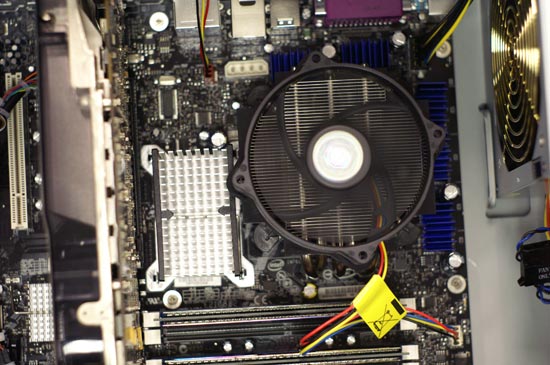
The modified BadAxe 2 board; can you spot the mod?
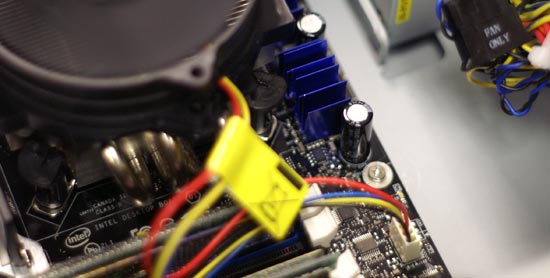
Can't find it? It's under that blue heatsink
The processors were plugged into a modified Intel BadAxe2 motherboard, with the modification being necessary to support Penryn. Each system had 2GB of DDR2-800 memory and a GeForce 8800 GTX. All of our tests were run under Windows XP.
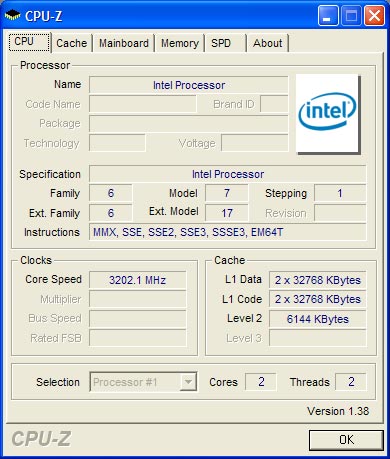
Wolfdale - 2 cores
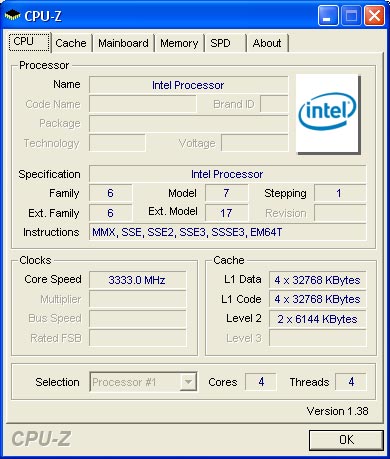
Yorkfield - 4 cores
The Cinebench 9.5 test is the same one we run in our normal CPU reviews, with the dual core Penryn (Wolfdale) scoring about 20% faster than the dual core Conroe. Keep in mind that the Wolfdale core is running at a 9.2% higher clock speed, but even if Cinebench scaled perfectly with clock speed there's still at least a 10% increase in performance due to the micro-architectural improvements found in Penryn.
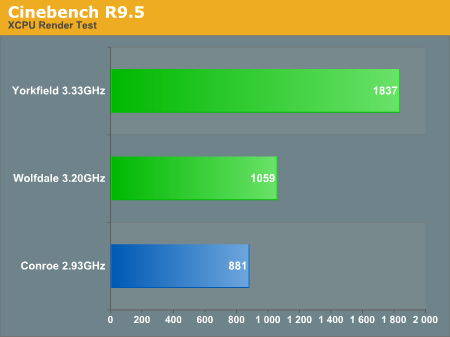
Next up was Intel's Half Life 2 Lost Coast benchmark which was run with the following settings:
| Setting | |
| Model Detail | High |
| Texture Detail | High |
| Shader Detail | High |
| Water Detail | Reflect World |
| Shadow Detail | High |
| Texture Filtering | Trilinear |
| HDR | Full |
Half Life 2 performance at a very CPU bound 1024 x 768 has Wolfdale just under 19% faster than Conroe. Once again, clock speed does play a part here but we'd expect at least a 10% increase in performance just due to the advancements in Penryn.
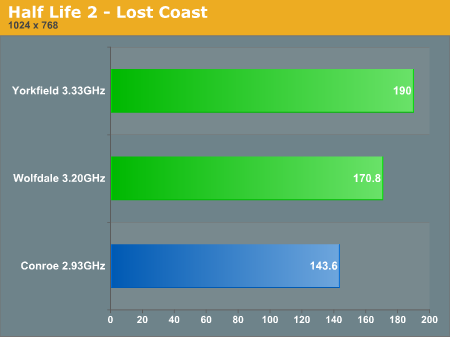
At 1600 x 1200 the performance difference shrinks to 10.6%, still quite respectable:
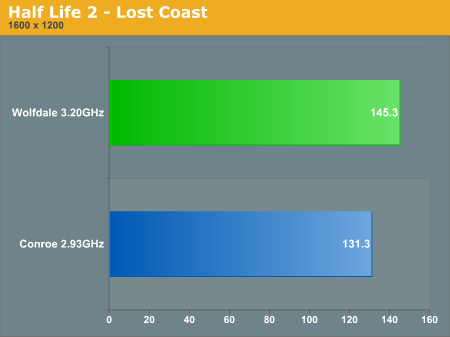










66 Comments
View All Comments
GlassHouse69 - Wednesday, April 18, 2007 - link
I would agree that things arent so fantastic with this chip except for cheaper production and lower power which is neato.however, the extra cache is useless for much although more cache always speeds things up.
if the chip had a real on die mem controller then it wouldnt need half that cache.....
pwnd
coldpower27 - Wednesday, April 18, 2007 - link
Sigh, it's not Intel's problem that AMD has lousy cache technology Intel has great expertise in cache so they can throw alot of it on.IMC while is one way to do things isn't the only way to do things, in the meantime, this is a nice boost over an existing design.
TA152H - Wednesday, April 18, 2007 - link
You apparently aren't taking into account that Intel has a bigger cache BECAUSE they don't waste real estate on the memory controller. Both companies can't make huge processors for the mainstream market, because they'd be too expensive so they have to choose what to spend size on. Have you seen an Athlon 64 die? The memory controller is a very large part of it. Memory is very small for the amount of transistors it uses, and you can get a lot of bang for the buck by adding cache in that space instead of a memory controller.One thing, it's almost funny how poorly informed people are about cache. A bigger cache does NOT make for better speed in every case. The larger the cache, the more time it takes to read, in general terms. Look at the 65 nm AMD processors; they added wait states so they could add a larger cache later on. And it's not a clear as saying that they know it's better if they add so much cache for so many wait states, it depends on the applications. Plus, you increase power use, and dissipate more heat, and sometimes the cache is the limiting factor in how fast you can clock a processor unless you add the wait states (Pentium III Coppermine, for example, had a miserable time getting over 1 GHz because of the L2 cache, the Celeron version with an additional wait state got to 1.1 GHz).
I also think the level of expectation is out of control for these hobbyist site viewers. This is just a shrink, or should be, and any boost at all should be viewed favorably. The fact they did more than a shrink is great, and if they get even four percent I'd view that as excellent, it was only a year ago they introduced a fantastic processor. Comparing the changes from the P7 to the P8 is uninformed, not only because the P7 sucked bad, and was probably Intel's worst processor (or maybe the 432, or i860, or 8008?, etc...), but also because it was a complete overhaul vis-a-vis the P7, and even compared to a P6+ (Pentium M line), it had major changes.
Comparing an AMD processor to this group would have been absurd. First of all, they were doing it under Intel's supervision, and also this is not a selling processor. You'd have to compare it to AMD's next generation, which they aren't giving out yet, so the best thing is to just compare it with Intel's current stuff so people can extrapolate from that how it will compare to AMD's existing processors, and upcoming processors.
Anyone counting AMD out is an idiot, plain and simple. While we may not have specifics on the product, we do have the actions of both Intel and AMD to look at, and they all point to the product being excellent, and at least roughly as good as Intel's. Intel is revealing all sorts of stuff they wouldn't otherwise do, and AMD is desperately clinging to market share even at the cost of losing money, so when their new core comes out, they will be in all these lines of machines from companies. Intel is trying to break them before it happens. Why if the product sucks? It doesn't, Intel knows they have problems on the horizon and everything they've done has demonstrated that, there isn't really any other explanation. You don't do that when the upcoming competitor's product sucks, you give too much away for almost no benefit. And they do know what it can do, and they are doing what they can to limit the impact of it.
coldpower27 - Wednesday, April 18, 2007 - link
Oh but I am that is only part of the equation, Intel does have better cache density on a given process then AMD does. Working with Itanium has made that a necessity.Yeah, a IMC does indeed take alot of die area, core logic is on the lower end of the transistor density on a given process.
IMC + HSI doesn't help either in ALL cases that don't stress memory bandwidth so this argument is basically tit for tat. Larger caches help as you have more available memory closer to the processor, how much in each situation varies on how much data needs to be worked on. IMC does the same thing except instead of making the LV2 bigger, you make the latency between main memory and the CPU lower so you can get data quicker, which is the same idea as more LV2 more data on hand.
Cache is typically the lowest power stuff on the CPU die, it the main core logic which increases power consumption for the most part.
This is more then your usual optical shrink. Intel for the most part doesn't do those, they usually add more cache with each successive generation. There are some improvements to the core functionality, not an major overhaul like Yonah to Merom but enough to maybe give some nice boosts, no more then 10% at the most I would gather on an IPC level.
Now your just going off on a wild tangent, the NetBurst architecture was designed to be sexy and flashy and worked well for quite sometime. It sold on CPU clockspeed as most people don't understand the concept of IPC, and it wasn't till sub 100nm that heat issue became the limiting factor.
Well having the reference point there would be interesting, as we need to see how much AMD needs to improve to get to Merom/Conroe and later on Penryn/Wolfdale levels. We want to compare it to Bareclona but AMD's has been so tight lipped on that, so such a comparison can't be done.
Of course AMD isn't finished, though I don't believe your confidence in AMD is as well founded as it may seem. AMD so far has only given us vague conclusions on Barcelona performance and pretty much showed a scenario heavily playing to AMD's own strengths specFP would run best on AMD as one it's quite memory bandwidth dependent so with Barcelona vs Clovertown, Intel's FSB starts to become a limiting factor. As well K8 is already pretty much at parity with regard to FP resources to Core, K10 is known to be doubling the FP resources so it doing well in FP is not surprising.
Intel is a very smart corporation, and know how to generate awareness and interest in it's products unlike AMD. The information release such as this is a great PR move as it shows Intel is confident and doesn't have anything to hide, and doesn't leave the customer always guessing. It also hurts AMD as some people will be waiting for these new products to arrive since at least with these you know what's going to happen and they are a safe bet.
You have to understand Intel is currently focused on regaining mindshare and marketshare. What Intel has done today is quite a marketing coup, it showed 45nm benchmarks before AMD has released any information on anything other then synthetics on their K10.
There shouldn't be any doubt that K10 will be superior to K8, since the design is evolutionary, so it will be a good product, but the question we all want to know. Will it beat Intel's equivalents in the desktop environment? In Single Socket systems FSB is just fine and basically not much of an issue. I expect Bareclona to reamin ahead against Clovertown and Tigerton, but the lead will have substantially deminished in the 4P sector as the jump from Santa Rosa to Barcelona is smaller then Tulsa to Tigerton.
TA152H - Wednesday, April 18, 2007 - link
IMC + HSI stuff is your own argument. Don't put words in my mouth, I never said it always did help. I was just saying that larger isn't always better with respect to caches, nothing more, nothing less.Caches do take power, why do they power some of them down in mobiles if they aren't significant?
The P7 was never a good processor, it sucked from day one and sucked worse as time went along. It was a marketing tool, and a technological showpiece, but it sucked in terms of being useful. There were some benchmarks where it could beat the K7, for sure, but at what cost? The processor was enormous by comparison, used massive amounts of heat, and was being compared to an older processor. They had to kill off the Tualatin with enormous prices because it was too good vis-a-vis the P7, this despite a severe memory bottleneck on it. So, I don't buy it was ever good, I was horrified when I learned about it. The size, heat, etc... compared to performance was absolutely terrible from day one, and only their manufacturing capability allowed them to remain competitive, until the K8. The Prescott just made things worse, but it was all sizzle; that steak was made out of horse.
Heat is always an issue. That's why you'd get higher clock speeds with better cooling even with the K7 and P6. However, the miserable P7 design was the first one that heat became a huge problem well before the speed the transistors could work at was reached. It's also always an issue because you have to cool it, not only with fans in the case, but also, for a server room, you have to get it out of the building. It's always an issue, and the P7 was the worst processor ever made, relatively speaking, in that regard. Just horrible.
Of course this is more than a shrink. That much is beyond obvious.
If you can't extrapolate the data from the comparison to see how much AMD needs to improve, I doubt putting them in there would help that much. Besides, for that to matter, you'd have to be able to adequately define how much AMD CAN improve. You can't, I can't, so it's meaningless. The Core 2 is a fine processor, but it's not particularly advanced. AMD should have no problem adding such things as memory disambiguation, and in fact have already stated they have. The end product won't trail Intel by much, if any, how could it? The main problem is the scheduling, which AMD says they have fixed in much the same way Intel did with Core 2. The difference was, the P6 was always better than the K7 and K8, although not as wide, so they'll end up the same place. There may be differences, but they aren't going to be enormous.
Intel is a really stupid corporation too, look at the P7. They really understood the market right with RDRAM and Itanium, right? Sometimes they get it right, sometimes they don't, but talking about a company that has screwed up as much as they reverently is absurd. Were it not for their egregious mistakes, AMD wouldn't have won 25+ market share, would they?
Releasing information too soon is more often than not a mistake. You have to have a reason for it, or you're plain stupid. They do, obviously, they want to distract attention from AMD. If AMD gets people too excited about a product they aren't shipping, guess what people do? They wait and don't buy stuff already out there. That's why companies typically don't say too much or build up too much excitement, people don't buy what they're selling now and we already know AMD is having problems selling processors. This would help them how? So, people on hobby site chatboards would say nicer things about them? I don't think they care that much; if the processor is great when they release it, they don't need to say too much beforehand. If it is great, they'd be foolish to since it would kill existing sales. For businesses, and such, they are probably saying more, but I don't have any contacts with AMD anymore so I don't know for sure. They are giving people server numbers, and that will make people wait before doing their budget. So, I think they're being extremely rational. Intel is saying an awful lot, and it makes me wonder why. I wouldn't even consider buying a Conroe now, I'll wait for the Penryn, or AMD's chip. I was on the fence before reading this, since my development machine is driving me crazy it's so slow (2.4 GHz AMD).
Everything is evolutionary now, sort of. The P6 was the starting point for everything but the horrible P7. The Athlon wasn't that different. The Athlon 64 isn't that different from the Athlon. The Pentium M's weren't that different from the Tualatin, and the Yonah wasn't that different either. The Core is a little wider, and has better scheduling, but it's just an evolutionary step. The P7 was revolutionary, with the amazing array of technology it had, and so was the Itanium, but one is dead, and the other currently irrelevant except in the HPC market.
Zirconium - Wednesday, April 18, 2007 - link
The Wolfdale processor has the same FSB as the X6800. It does, however, have 6 megs of cache. Does that entirely account for the other ~10%? Maybe, maybe not. In either case, if I had a choice between a Conroe and a Wolfdale at the same clock, I'd probably take the Wolfdale.Komodo - Wednesday, April 18, 2007 - link
The difference between 18 and 38 sec is not 52,6% but 111% (in DivX 6.6 Results).retrospooty - Wednesday, April 18, 2007 - link
Zat you santy clause? ;)JarredWalton - Wednesday, April 18, 2007 - link
Corrected, along with the HL2 percentage being off.dm - Wednesday, April 18, 2007 - link
The future looks bright with Penryn :)